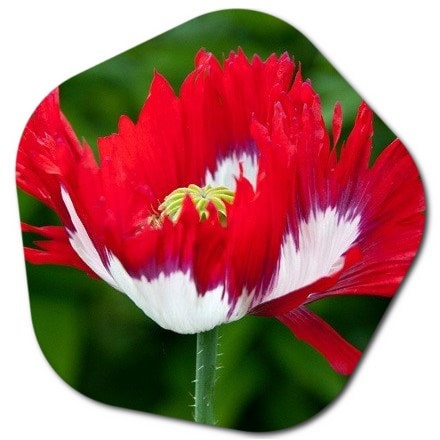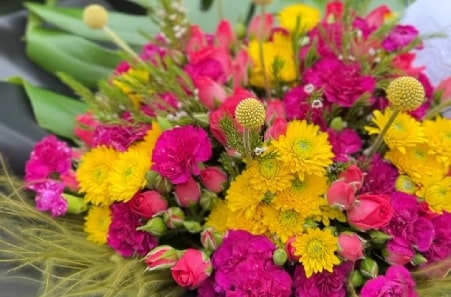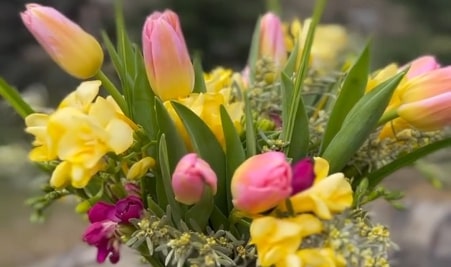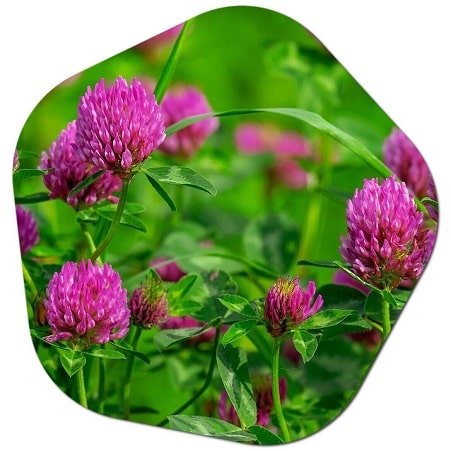Popular flower varieties grown in Denmark
Denmark is known for its picturesque flower fields, particularly during the spring and summer seasons. While there might not be vast flower fields like those found in some other countries, there are still several beautiful locations in Denmark where you can find stunning displays of flowers. Denmark is known for its beautiful gardens and flower cultivation. Some popular flower varieties grown in Denmark include:
- Danish Flag Poppy (Papaver somniferum ‘Danish Flag’): This iconic flower features large, papery red petals with a distinctive white cross in the center, resembling the Danish flag.
- Hydrangea (Hydrangea macrophylla): These flowering shrubs are loved for their large, showy flower heads that come in various colors, including pink, blue, and white. Hydrangeas are commonly grown in Danish gardens.
- Dahlia (Dahlia): Dahlias are cherished for their stunning blooms in a wide range of colors, shapes, and sizes. These summer and fall flowers are popular choices in Danish gardens and floral arrangements.
- Geranium (Geranium): Geraniums are versatile flowering plants that are appreciated for their vibrant blooms and attractive foliage. They come in various colors, including shades of pink, purple, and white, and are commonly seen in Danish gardens.
- Peony (Paeonia): Peonies are beloved for their large, fragrant flowers in shades of pink, red, and white. These elegant blooms are a favorite in Danish gardens and are often used in floral arrangements.
- Tulip (Tulipa): Tulips are classic spring flowers that are widely grown in Denmark. With their diverse colors and shapes, tulips bring vibrant beauty to gardens, parks, and even tulip festivals in Denmark.
- Rose (Rosa): Roses are timeless favorites, and many varieties are grown in Danish gardens. From hybrid teas to climbers and shrub roses, they add elegance and fragrance to the landscape.
- Lavender (Lavandula): While not native to Denmark, lavender is cultivated in the country. Its fragrant flowers and aromatic foliage are valued for their calming properties and are often used in gardens and for herbal purposes.

These are just a few examples of popular flower varieties grown in Denmark. The country’s temperate climate and fertile soil provide favorable conditions for a wide range of flowers to thrive. Danish gardens showcase a colorful array of flowers, and these varieties contribute to the beauty of the landscape.
What are the most common flowers in Denmark?
Some of the most common flowers found in gardens and landscapes in Denmark include:
- Marguerite Daisy (Leucanthemum vulgare): This wildflower is commonly seen in Danish meadows and fields. It has white petals surrounding a yellow center and is often associated with a classic daisy appearance.
- Forget-Me-Nots (Myosotis): These delicate, small blue flowers are beloved in Denmark. They grow in clusters and have five petals, symbolizing remembrance and loyalty.
- Pansies (Viola tricolor): Pansies are popular cool-season flowers in Denmark. They come in various vibrant colors and have distinctive “faces” on their petals, making them a charming addition to gardens and containers.
- Bellis Perennis (English Daisy): Known as “storkenæb” in Danish, these small daisy-like flowers have pink or white petals with a yellow center. They are often seen in lawns or used as groundcover.
- Cosmos (Cosmos bipinnatus): Cosmos flowers with their feathery foliage and daisy-like blooms are commonly grown in Danish gardens. They come in various colors, including shades of pink, white, and maroon.
- Marigold (Tagetes): Marigolds are popular annual flowers in Denmark. They have vibrant orange or yellow flowers and are often used as border plants or in containers due to their cheerful appearance and pest-repellent properties.
- Nasturtium (Tropaeolum): Nasturtiums are beloved for their bright orange, red, and yellow flowers. They have rounded, lily pad-shaped leaves and can be trailing or bushy, making them popular for hanging baskets and garden edges.
- Snapdragons (Antirrhinum): Snapdragons are known as “løve’s gab” in Danish, which translates to “lion’s mouth.” These flowers have distinctive, elongated petals that resemble the face of a dragon. They come in various colors and are commonly seen in Danish gardens.

These flowers are widely cultivated in Denmark due to their adaptability to the climate and their ability to thrive in Danish garden conditions. They bring color, beauty, and charm to the Danish landscape throughout the growing season.
What is Denmark’s famous flower?
Denmark’s famous flower is the Marguerite Daisy (Leucanthemum vulgare), also known as the common daisy or the ox-eye daisy. This flower is an iconic symbol of Denmark and is often associated with Danish meadows and fields. The Marguerite Daisy has white petals surrounding a yellow center and is recognized for its simplicity and beauty. It is commonly found in the Danish countryside and is celebrated as a national flower, representing the natural landscapes and flora of Denmark.
Are there endemic flowers growing in Denmark?
Denmark, being a relatively small country, does not have a large number of endemic flowers. Endemic species are those that are native and exclusive to a particular region. However, Denmark does have a few native and wildflower species that can be considered endemic or native to the region. Some examples include:

- Danish Scurvygrass (Cochlearia danica): This small, flowering plant is native to coastal areas of Denmark. It has small white flowers and is adapted to grow in sandy and rocky coastal habitats.
- Marsh Gentian (Gentiana pneumonanthe): This native wildflower can be found in wetlands and meadows across Denmark. It has deep blue, trumpet-shaped flowers and is known for its preference for acidic soils.
- Hairy Violet (Viola hirta): This native violet species is found in Denmark, particularly in dry and sandy habitats. It has distinctive hairy leaves and delicate purple flowers.
- Fen Orchid (Liparis loeselii): This rare orchid species is native to Denmark and other parts of Europe. It grows in wet fen habitats and has small, greenish-yellow flowers.
While these species are considered native or endemic to Denmark, they may also be found in neighboring regions. Denmark’s flora is influenced by its geographical location and shared plant species with surrounding countries.
What is the national flower of Denmark?
The national flower of Denmark is the red clover (Trifolium pratense). The red clover is a common plant found in meadows and fields throughout Denmark. It is known for its vibrant pinkish-red flowers and trifoliate leaves. The red clover has cultural significance in Denmark and is recognized as a symbol of the country’s agricultural heritage and natural landscapes. It represents the connection to the land and the beauty of Danish countryside. National animal of Denmark >>
Why is the daisy the national flower of Denmark?

The national flower of Denmark is not the daisy, but the red clover (Trifolium pratense), as mentioned in the revised response above. The red clover holds cultural significance in Denmark as a symbol of the country’s agricultural heritage and natural landscapes. It represents the connection to the land and the importance of agriculture in Danish society. Once again, I apologize for the confusion caused by the previous incorrect response regarding the national flower of Denmark. What are the most common flowers in Denmark? >>
Flower fields in Denmark
Denmark is known for its picturesque flower fields, particularly during the spring and summer seasons. While there might not be vast flower fields like those found in some other countries, there are still several beautiful locations in Denmark where you can find stunning displays of flowers. Here are a few notable places to visit:
- Fur Island (Fur Ø): Fur Island is located in the Limfjord in northern Denmark and is known for its scenic landscapes and wildflowers. In the spring and early summer, the island’s meadows and fields are covered with colorful flowers, including daisies, poppies, and orchids.
- Ærø Island: Ærø Island, located in the southern part of Denmark, offers charming coastal scenery and flower-filled landscapes. The island is home to meadows and fields adorned with wildflowers such as poppies, daisies, and lupines, creating a beautiful backdrop for nature enthusiasts and photographers.
- Langeland Island: Langeland Island, situated in the South Funen Archipelago, is known for its diverse natural beauty. The island boasts picturesque landscapes with flower-filled meadows, including areas where orchids can be found. This makes it a popular destination for nature lovers and birdwatchers.
- Tivoli Gardens: While not a natural flower field, Tivoli Gardens in Copenhagen is a well-known amusement park with beautifully landscaped gardens. The park features meticulously maintained flowerbeds, colorful displays, and seasonal flower arrangements that create a vibrant and enchanting atmosphere.
It’s important to note that the timing and availability of flower fields can vary depending on the weather and season. It’s recommended to check with local tourism offices, garden parks, or botanical gardens for the latest information on flower displays and bloom times in specific regions of Denmark.





